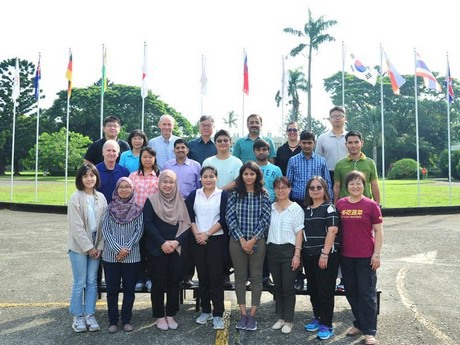A group of young plant pathologists attended a two-week training course at WorldVeg headquarters to immerse themselves in best practices for sample collection and pest and disease diagnosis.
An international training workshop on “Methods for disease and insect resistance screening for germplasm characterization and vegetable breeding” held at WorldVeg headquarters in Taiwan from 23 September to 4 October 2019 saw nine participants from the Department of Agriculture and Agrifood (Brunei Darussalam), Clover Seed Co. Ltd. (Hong Kong), VNR Seeds Pvt. Ltd. and Kaveri Seed Company Ltd. (India), and Chiatai Company (Thailand) work closely with WorldVeg researchers on diagnosis methods, sample preparation, field identification of pests and diseases, and much more.
“It was great to have these young and enthusiastic scientists on our campus for two weeks,” said Roland Schafleitner, Flagship Leader for Vegetable Diversity and Improvement.

Each day brought exposure to new methods and knowledge. From 23-26 September, Virologists Lawrence Kenyon and Yuan-li Chan introduced virology basics, demonstrated screening protocols and methods for recording virus symptoms, and had the participants practice their new diagnostic skills. The Virology lab team (Su-ling Shih, Le-mei Lee and Fu-shun Kuo) guided hands-on practice in preparing gels for polymerase chain reaction (PCR) and enzyme-linked immunosorbent assay (ELISA) and the mechanical inoculation of viruses. Zeke Sheu covered fungal diseases on peppers, while Wallace Chen did the same for tomato; participants learned how to use FTA cards to collect samples for analysis.
Bacteria supplanted viruses on 27-30 September as Jaw-rong Chen and the Bacteriology team worked with the participants on diagnosis and inoculum preparation for bacterial diseases. Nematodes nudged bacteria from the spotlight when Ravishankar Manickam shared tips for field identification of root-knot diseases and isolation of root-knot nematodes and egg masses for screening.
“WorldVeg is really advanced in pathological screening technologies,” participant Tavi Saxena from VNR Seeds Pvt. Ltd., India said. “I’m fortunate to learn the screening methodologies WorldVeg uses.”
Entomologists Srinivasan Ramasamy and Paola Sotelo Cardona introduced the major insect and mite pests on vegetable crops and explained resistance screening methods on 1-2 October. Participants then headed to the field to collect pests and carry out diagnosis in the insectary. Srini, Paola and Mei-ying Lin helped the participants score selected germplasm accessions for pest resistance and conduct statistical analyses.
On 3 October, Roland Schafleitner showed the new Phenopsex field phenotyping system to the group. Maureen Mecozzi guided participants through the WorldVeg Demonstration Garden, a 0.6 hectare garden featuring traditional vegetables and improved WorldVeg lines. The group got a closer look at the WorldVeg Genebank with Yung-kuang Huang.
On 4 October, Roland Schafleitner reviewed molecular-marker assisted breeding for disease resistance, and the participants wrapped up their course with discussions on nematology and bacteriology, and by evaluating and scoring disease severity and nematode inoculation for various vegetables. A farewell dinner with the trainers coordinated by Teresa Liang was the perfect way to complete the course.
“Before I didn’t know about screening,” said participant Ratchupon Sangrichan of the Chiatai Co., Bangkok. “Now I have inspiration how to improve my work.”
For more information: World Vegetable Center
World Vegetable Center
avrdc.org
